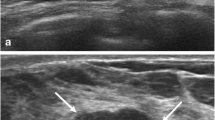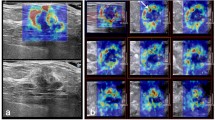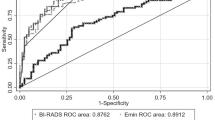Abstract
Objectives
To investigate whether mass stiffness measured by shear-wave elastography (SWE) can predict the histological upgrade of ductal carcinoma in situ (DCIS) confirmed through ultrasound (US)-guided core needle biopsy (CNB).
Methods
The institutional review board approved this study and informed consent was waived. A database search revealed 120 biopsy-confirmed DCIS in patients who underwent B-mode US and SWE prior to surgery. Clinicopathologic results, B-mode findings, size on US, and mean and maximum elasticity values on SWE were recorded. Associations between upgrade to invasive cancer and B-mode US findings, SWE information, and clinical variables were assessed using univariate, multivariate logistic regression, and multiple linear regression analysis.
Results
The overall upgrade rate was 41.7 % (50/120). Mean stiffness value (P = .014) and mass size (P = .001) were significantly correlated with histological upgrade. The optimal cut-off value of mean stiffness value, yielding the maximal sum of sensitivity and specificity, was 70.7 kPa showing sensitivity of 72 % and specificity of 65.7 % for detecting invasiveness. Qualitative elasticity colour scores were significantly correlated with the histological upgrade, mammographic density, and B-mode category (P < .04).
Conclusion
Mean stiffness values evaluated through SWE can be utilized as a preoperative predictor of histological upgrade to invasive cancer in DCIS confirmed at US-guided needle biopsy.
Key Points
• Higher stiffness values were noted in invasive cancer than DCIS.
• Qualitative SWE colour scores significantly correlated with the histological upgrade.
• Qualitative SWE colour scores had excellent interobserver agreement.



Similar content being viewed by others
Abbreviations
- DCIS:
-
Ductal carcinoma in situ
- IDC:
-
Invasive ductal carcinoma
- SWE:
-
Shear-wave elastography
- CNB:
-
Core needle biopsy
References
Donahue EJ (2014) Ultrasound-Guided Breast Biopsy Tissue Sampling: Technique and Breast Ultrasound Characteristics of Benign and Malignant LesionsBreast Cancer. Springer, p 133–148
Kim J, Han W, Lee JW et al (2012) Factors associated with upstaging from ductal carcinoma in situ following core needle biopsy to invasive cancer in subsequent surgical excision. Breast 21:641–645
Houssami N, Ambrogetti D, Marinovich ML et al (2011) Accuracy of a preoperative model for predicting invasive breast cancer in women with ductal carcinoma-in-situ on vacuum-assisted core needle biopsy. Ann Surg Oncol 18:1364–1371
Kurniawan ED, Rose A, Mou A et al (2010) Risk factors for invasive breast cancer when core needle biopsy shows ductal carcinoma in situ. Arch Surg 145:1098–1104
Brennan ME, Turner RM, Ciatto S et al (2011) Ductal carcinoma in situ at core-needle biopsy: meta-analysis of underestimation and predictors of invasive breast cancer. Radiology 260:119–128
Chang W-C, Hsu H-H, Yu J-C et al (2014) Underestimation of invasive lesions in patients with ductal carcinoma in situ of the breast diagnosed by ultrasound-guided biopsy: a comparison between patients with and without HER2/neu overexpression. Eur J Radiol 83:935–941
Schulz S, Sinn P, Golatta M et al (2013) Prediction of underestimated invasiveness in patients with ductal carcinoma in situ of the breast on percutaneous biopsy as rationale for recommending concurrent sentinel lymph node biopsy. Breast 22:537–542
Park SH, Kim MJ, Kim SJ, Kim E-K (2014) Ductal carcinoma in situ diagnosed using an ultrasound-guided 14-gauge core needle biopsy of breast masses: can underestimation be predicted preoperatively? Ultrasonography 33:128
Moran CJ, Kell MR, Flanagan FL, Kennedy M, Gorey TF, Kerin MJ (2007) Role of sentinel lymph node biopsy in high-risk ductal carcinoma in situ patients. Am J Surg 194:172–175
Hung WK, Ying M, Chan M, Mak KL, Chan LK (2010) The impact of sentinel lymph node biopsy in patients with a core biopsy diagnosis of ductal carcinoma in situ. Breast Cancer 17:276–280
Lyman GH, Temin S, Edge SB et al (2014) Sentinel lymph node biopsy for patients with early-stage breast cancer: American Society of Clinical Oncology clinical practice guideline update. J Clin Oncol 32:1365–1383
Barr RG (2010) Real-time ultrasound elasticity of the breast: initial clinical results. Ultrasound Q 26:61–66
Barr RG, Destounis S, Lackey LB, Svensson WE, Balleyguier C, Smith C (2012) Evaluation of breast lesions using sonographic elasticity imaging a multicenter trial. J Ultrasound Med 31:281–287
Athanasiou A, Tardivon A, Tanter M et al (2010) Breast lesions: quantitative elastography with supersonic shear imaging—preliminary results 1. Radiology 256:297–303
Berg WA, Cosgrove DO, Doré CJ et al (2012) Shear-wave elastography improves the specificity of breast US: the BE1 multinational study of 939 masses. Radiology 262:435–449
Itoh A, Ueno E, Tohno E et al (2006) Breast Disease: Clinical Application of US Elastography for Diagnosis 1. Radiology 239:341–350
Destounis S, Arieno A, Morgan R et al (2013) Clinical experience with elasticity imaging in a community-based breast center. J Ultrasound Med 32:297–302
Cosgrove DO, Berg WA, Dore CJ et al (2012) Shear wave elastography for breast masses is highly reproducible. Eur Radiol 22:1023–1032
Chang JM, Moon WK, Cho N et al (2011) Clinical application of shear wave elastography (SWE) in the diagnosis of benign and malignant breast diseases. Breast Cancer Res Treat 129:89–97
Evans A, Whelehan P, Thomson K et al (2010) Quantitative shear wave ultrasound elastography: initial experience in solid breast masses. Breast Cancer Res 12:R104
Evans A, Whelehan P, Thomson K et al (2012) Invasive breast cancer: relationship between shear-wave elastographic findings and histologic prognostic factors. Radiology
Zeichner SB, Herna S, Mani A et al (2015) Survival of patients with de-novo metastatic breast cancer: analysis of data from a large breast cancer-specific private practice, a university-based cancer center and review of the literature. Breast Cancer Res Treat 153:617–624
Choi WJ, Kim HH, Cha JH et al (2014) Predicting prognostic factors of breast cancer using shear wave elastography. Ultrasound Med Biol 40:269–274
Chen L, He J, Liu G et al (2014) Diagnostic performances of shear-wave elastography for identification of malignant breast lesions: a meta-analysis. Jpn J Radiol 32:592–599
Cho N, Moon WK, Chang JM et al (2011) Sonoelastographic lesion stiffness: preoperative predictor of the presence of an invasive focus in nonpalpable DCIS diagnosed at US-guided needle biopsy. Eur Radiol 21:1618–1627
Sickles E, D'Orsi CJ, Bassett LW et al (2013) ACR BI-RADS® MammographyACR BI-RADS® Atlas, Breast Imaging Reporting and Data System. American College of Radiology, Reston
Chang JM, Park IA, Lee SH et al (2013) Stiffness of tumours measured by shear-wave elastography correlated with subtypes of breast cancer. Eur Radiol 23:2450–2458
Elston CW, Ellis IO (1991) Pathological prognostic factors in breast cancer. I. The value of histological grade in breast cancer: experience from a large study with long-term follow-up. Histopathology 19:403–410
Mendelson EB, Böhm-Vélez M, Berg WA et al (2013) ACR BI-RADS® Ultrasound.ACR BI-RADS® Atlas, Breast Imaging Reporting and Data System. American College of Radiology, Reston
Berg WA, Mendelson EB, Cosgrove DO et al (2015) Quantitative Maximum Shear-Wave Stiffness of Breast Masses as a Predictor of Histopathologic Severity. Am J Roentgenol 205:448–455
Chamming’s F, Latorre-Ossa H, Le Frère-Belda M et al (2013) Shear wave elastography of tumour growth in a human breast cancer model with pathological correlation. Eur Radiol 23:2079–2086
Shoma A, Moutamed A, Ameen M, Abdelwahab A (2006) Ultrasound for accurate measurement of invasive breast cancer tumor size. Breast J 12:252–256
Hieken TJ, Harrison J, Herreros J, Velasco JM (2001) Correlating sonography, mammography, and pathology in the assessment of breast cancer size. Am J Surg 182:351–354
Lee JW, Han W, Ko E et al (2008) Sonographic lesion size of ductal carcinoma in situ as a preoperative predictor for the presence of an invasive focus. J Surg Oncol 98:15–20
Moon WK, Myung JS, Lee YJ, Park IA, Noh D-Y, Im J-G (2002) US of Ductal Carcinoma In Situ 1. Radiographics 22:269–281
Londero V, Zuiani C, Furlan A, Nori J, Bazzocchi M (2007) Role of ultrasound and sonographically guided core biopsy in the diagnostic evaluation of ductal carcinoma in situ (DCIS) of the breast. Radiol Med 112:863–876
Cho N, Moon WK, Park J-S (2009) Real-time US elastography in the differentiation of suspicious microcalcifications on mammography. Eur Radiol 19:1621–1628
Tunon-de-Lara C, Chauvet MP, Baranzelli MC et al (2015) The Role of Sentinel Lymph Node Biopsy and Factors Associated with Invasion in Extensive DCIS of the Breast Treated by Mastectomy: The Cinnamome Prospective Multicenter Study. Ann Surg Oncol :1–8
Worni M, Akushevich I, Greenup R et al (2015) Trends in treatment patterns and outcomes for ductal carcinoma in situ. J Natl Cancer Inst 107:djv263
Yi A, Moon WK, Cho N et al (2013) Association of tumour stiffness on sonoelastography with axillary nodal status in T1 breast carcinoma patients. Eur Radiol 23:2979–2987
Lee SH, Cho N, Chang JM et al (2014) Two-view versus single-view shear-wave elastography: comparison of observer performance in differentiating benign from malignant breast masses. Radiology 270:344–353
Youk JH, Son EJ, Gweon HM, Kim H, Park YJ, Kim J-A (2014) Comparison of Strain and Shear Wave Elastography for the Differentiation of Benign From Malignant Breast Lesions, Combined With B-mode Ultrasonography: Qualitative and Quantitative Assessments. Ultrasound Med Biol 40:2336–2344
Acknowledgments
The scientific guarantor of this publication is Woo Kyung Moon. The authors of this manuscript declare no relationships with any companies, whose products or services may be related to the subject matter of the article. The authors state that this work has not received any funding. One of the authors has significant statistical expertise. Institutional Review Board approval was obtained. Written informed consent was waived by the Institutional Review Board. Methodology: retrospective, observational, performed at one institution.
Author information
Authors and Affiliations
Corresponding author
Rights and permissions
About this article
Cite this article
Bae, J.S., Chang, J.M., Lee, S.H. et al. Prediction of invasive breast cancer using shear-wave elastography in patients with biopsy-confirmed ductal carcinoma in situ. Eur Radiol 27, 7–15 (2017). https://doi.org/10.1007/s00330-016-4359-6
Received:
Accepted:
Published:
Issue Date:
DOI: https://doi.org/10.1007/s00330-016-4359-6




